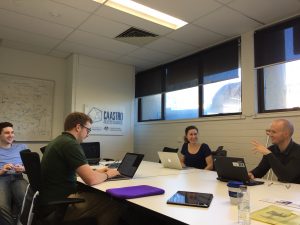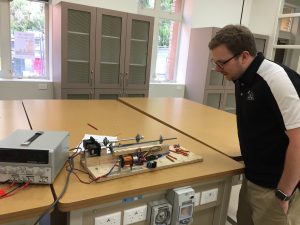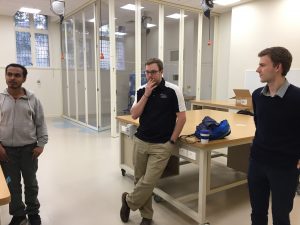Cubesat Expert Visit and Student Projects
Greetings from Cubesat Central!  We recently wrapped up an extremely productive visit from Dr James Mason, a cubesat expert from the Laboratory for Atmospheric and Space Physics in Boulder, Colorado. James was one of the leads in designing, building, and operating a fantastically successful solar-observing cubesat called MinXSS, and has contributed to a few others. As MinXSS was primarily a student-led project, we invited James to visit and share his expertise in not only cubesat development, but also the best way to bring students into the process. SkyHopper team member Dr Katie Mack received generous funding from the University of Melbourne in the form of the Dyason Fellowship to fly James across the ocean for a two-week visit, during which we kept him busy consulting on SkyHopper design and meeting with students who may be involved in the project.
We recently wrapped up an extremely productive visit from Dr James Mason, a cubesat expert from the Laboratory for Atmospheric and Space Physics in Boulder, Colorado. James was one of the leads in designing, building, and operating a fantastically successful solar-observing cubesat called MinXSS, and has contributed to a few others. As MinXSS was primarily a student-led project, we invited James to visit and share his expertise in not only cubesat development, but also the best way to bring students into the process. SkyHopper team member Dr Katie Mack received generous funding from the University of Melbourne in the form of the Dyason Fellowship to fly James across the ocean for a two-week visit, during which we kept him busy consulting on SkyHopper design and meeting with students who may be involved in the project.

One of the key goals of our discussions was to create a roadmap for collaboration with the Melbourne Space Program, a Melbourne University-based volunteer student organization that is developing a small (1U) cubesat of its own. With over 30 regularly active members, they’re doing some really impressive work toward the launch of a completely student-built cubesat that they’ve designed and built from scratch, so they’re a natural partner for SkyHopper. Student involvement in the project is a key element of the SkyHopper program — as SkyHopper will (hopefully!) become Australia’s first space telescope, we have a great opportunity to engage students and to help them develop skills that will be massively advantageous in an increasingly high-tech, space-oriented innovation economy.
Over the course of James’ visit, we had productive meetings with Melbourne Space Program leadership and team members, and even got a chance to check out their workshop, where, among other things, they are using 3D printing and a custom-made magnetorquer rig to build an orientation system for their cubesat-in-progress, CS-1.
The meetings were a promising start to a productive collaboration between SkyHopper, James, and the Melbourne Space Program. James brought in his expertise to help the MSP students with their cubesat designs and plans, and our discussions laid the groundwork for internships and student projects that could bring MSP students into the SkyHopper team. We are looking forward to working with James and the MSP in the future, and to seeing Melbourne’s role in space technology really take off!




Categories